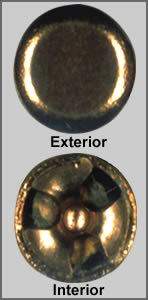- 01: Introduction
- 02: History
- 03: Propellants, Firearms, and Ammunition Development
- 04: Modern Firearms Manufacture
- 05: Small Arms Ammunition
- 06: Evidence Handling Procedures
- 07: Equipment and Instrumentation
- 08: Examination of Firearms
- 09: Cartridge and Shotshell Examination
- 10: Characterization and Evaluation of Fired Projectiles
- 11: Bullet Comparison and Identification
- 12: Gunshot Residue and Distance Determination
- 13: Toolmark Identification
- 14: Communicating Results
- Resources


Centerfire
Home > Small Arms Ammunition > Primer Manufacture > Centerfire

CCI primer cup
Centerfire primers are more complex because of their internal components. These primers have three to four components depending on the brand. All have a primer cup, an anvil, and the priming chemicals or mix. In many types, foil paper is placed between the mix and the anvil to facilitate assembly.
Most metallic primer cups are made of cartridge brass; steel may also be used. Similar to cups for cartridge cases or bullet jackets, primer cups are produced on a cupping press.
After cupping, the parts are tumbled to remove sharp edges at the open end of the cups. This smoothes the cup, making insertion in cartridge cases easier. Most commercial primer cups are nickel-plated for corrosion resistance.
Anvils, the smallest of ammunition components, are made on a small blanking press. Sheets of brass are fed into a press fitted with multiple blanking punches. Dies set below the punches shape the anvil into the three-dimensional form.
At the explosive chemical facility, the hazardous priming mix is blended. As with rimfire priming, the mix is kept wet for safe handling. Cups and anvils are delivered to the chemical facility for assembly.
As with rimfire priming, wet mix is forced into holes in a charge plate to set the correct volume of mix for each primer. The wet pellets are ejected into primer cups. A compaction press forms the pellet to fill the entire bottom of the cup. At this point, foil paper may be placed on top of the pellet to prevent it from sticking to the compaction pins.
Next, anvils are added to the charged cups. Aligned in close-fitting plates, they are pressed into the cups, leaving part of the anvil exposed above the edge of the cup. To provide moisture resistance and to help hold the parts in alignment, a drop of nitrate sealant is added to the assembled primer.
Visual inspection is important for assuring the quality of centerfire primers. The anvil must not be tipped or inverted; the foil paper must not be out of position. Although electronic image inspection systems are improving, they have not advanced to the standard of the human eye. Wet primers are dried, completing the primer manufacturing process.
Testing
Similar to primed rimfire cases, the centerfire primers are tested for adherence to sensitivity specifications. Unlike rimfire cases, centerfire primers must first be inserted in a standard brass cartridge case and tested as specified in the manufacturer’s drop-testing protocol.




